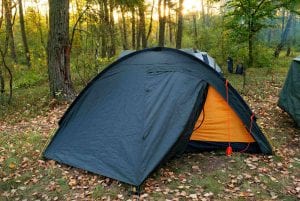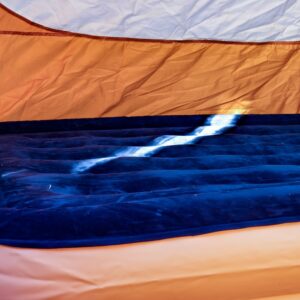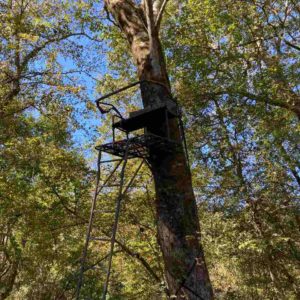We’ve all been there. The ominous buzz in your pocket.
LOW BATTERY. 15% POWER REMAINING.
Bad enough when you’re out and about in the city, but even more inconvenient when you’re 60 miles into the John Muir Trail.
Purists will hark back to the good old days when no-one had a smartphone and “we all managed just fine” — conveniently forgetting how useful it is to carry a device that you can use to navigate, check the weather, take pictures, let your family and friends know you’re safe, book accommodation, research and book travel arrangements, and summon help in an emergency.
A cell phone is pretty much an essential piece of outdoor kit, but keeping it juiced when you’re out on a hiking or camping trip can be a real challenge.
So how do you charge your phone while camping?
- The best way to keep your phone charged on a camping trip is to use a portable power bank.
- You can extend the battery life of your smartphone massively by making it dumber, keeping your phone warm, and deploying airplane mode to save power.
- Experienced hikers are opportunistic juicers, making the most of chances to charge their phone and power bank.
- A solar charger can be useful in certain circumstances, but a portable solar panel is rarely a stand-alone solution.
- Those operating out of fixed camps have more options, including larger power banks and BioLite stoves that generate electricity from fire.
Portable Power Banks
Ask most seasoned campers how they manage their electronic devices out on the trail and you’ll get the same answer: portable power banks.
A power bank is a compact charging device with a built in battery and USB ports. They’re ideal for keeping devices charged when you’re tent camping, and many are light enough for hiking trips.
The thing is, there are a lot of these portable chargers on the market — and it can be confusing to know which one to go for.
Buying a Portable Power Bank
When you’re buying a power bank to charge your phone while camping, you’ll want to consider some or all of the following factors…
- Capacity —This is usually articulated in mAh (miliamp hours). A cheap charging device might have a capacity of 2,500mAh, which won’t be enough to completely recharge a modern smartphone. A 10,000mAh version will give most phones two or three full charges, while if you’ve got multiple devices (or are using your phone for power-hungry stuff like navigation and video), a 20,000+mAh model might be a better call.
- Power Output — You’re not just looking for how it charges your devices (USB cable or wireless), but also how quickly it’ll charge them. USB-A ports can take a while to work their magic compared to faster-charging USB-C ports. Fast charging is a complicated and evolving business, and will depend partly on the devices you’re charging, but power banks will often have a maximum output that they can deliver through the charging cable, so it’s worth checking what that is.
- Input — Again, you’re not just looking for the USB port type (usually micro USB cable or USB C port), but how fast the power bank will charge. A 12-hour recharge time isn’t a problem if you’re spending a night in a hotel, but sometimes your opportunities to juice up might only last for the span of a meal or a couple beers. Some power banks offer a solar charge mode, and we’ll talk about that below.
- Weight — for a backpacker, every ounce matters. For a canoeist, not so much, and for a car camper, not at all. Power banks come in shapes and sizes to suit all of the above. You can pick up ones that weigh as little as a few ounces, though usually they won’t hold much charge. For thru-hikers, 12–15 oz seems to be the sweet spot, offering a decent number of charges and features at a tolerable weight.
You tend to get what you pay for with portable power banks. Cheaper models don’t usually hold much charge, and can take a long time both to charge your devices and to recharge themselves when you hook them up to a socket. And of course that might be fine if you’re only looking for a one-off charge on an overnight trip — but it might not be enough to keep your phone charged on longer camping trips.
There’s also the question of whether you go for a phone charger from a well-known brand (Anker or Belkin, for example) vs more obscure ones off Amazon. The latter are often a lot cheaper, and can be fine as a backup for the odd night away, but we’d be nervous about relying on them for extended trips in the back-country.
As with any other outdoor gear, it’s about working out what you actually need before you pull the trigger.
Larger Power Packs
If you’re a car camper, then you can take your off-grid living to the next level. These bad boys might weigh 20+ lbs, but can deliver enough juice to run even power-hungry appliances like hairdryers and kettles.
And, of course, a portable power station will also keep your phone charged while camping – much as you can use a sledgehammer to crack a nut.
Portable Solar Charger
There’s something pleasingly sci-fi about harnessing the power of the sun, whether that’s through solar powered speakers, led lights, or a solar charger to charge your phone.
Charging your phone battery via portable solar panels seems like a brilliant idea, but solar phone chargers aren’t quite as simple or practical as they sound.
To start with, it’s difficult to charge a phone directly from portable solar panels because of the variable output. Some phones will only accept charge at a certain rate, so it’s better to use your solar panels to charge a portable power pack — then top your phone up from that.
The other obvious problem with a portable solar panel is that you need a lot of surface area to generate enough power, especially if it’s cloudy and the solar panel isn’t in direct sunlight. If you’re operating out of a fixed camp where you can set up some decent-sized solar panels to help recharge your power bank, then it can be a great way to maintain charge levels, but it’s not so great if you’re limited to smaller panels that you can hang off a backpack.
That’s not to say solar chargers are no good at all for hikers. You can get portable panels that attach to the outside of your pack, and in the right conditions they can help top up your power bank.
It’s helpful to think of solar power as a way to help maintain charge levels, rather than as a stand-alone solution. Coupled with a good power bank and careful battery management, solar chargers can help you eke out your power during long thru-hikes.
Gas Generators
As rechargeable batteries improve, gas generators are becoming less important for camping trips, but a portable generator is still a useful power source for all kinds of tools and appliances. Clearly it’s overkill for a simple cell phone, but if you’ve got access to portable generator power then you might as well keep your phone charged while camping.
Electric Hook-ups
In these days of electronic devices and permanent connectivity, more and more campsite pitches offer electric hook-ups. Some might say that spoils the fun of it, but we say each to their own.
Some campsites also have communal areas like kitchens or lounges with lots of power points where you can charge your phone while you cook or watch TV. Unless there are signs specifically asking you not to do this, it’s understood that guests will use the power for their phones and other devices, and the cost will be included in your camping fee.
Of course, the only thing better than paying for an electric hook-up is using someone else’s for free…
Opportunism
Honestly, apart from a decent portable power bank, this is the best way to charge your phone on a camping trip. Just keep your eyes open, talk to people, and don’t be afraid to ask for a cheeky bit of power sometimes.
Over the years we’ve charged our phones in bars, cafes, and launderettes, in people’s houses and RVs, on trains and buses, in waiting rooms, tourist information centers, and public buildings.
Never let an opportunity to charge your phone pass you by, and if your cell has plenty of power, top your power bank up instead.
Car Charger
Another obvious one, but if you’re car camping and going on excursions then you want to get that cell phone plugged into the car charger as soon as you set off.
Hand Crank Generators
Hand crank cell phone chargers seem like a great idea. Chances are, somewhere in your outdoor gear box, you’ve got a useful hand crank torch or radio, so it seems logical that you ought to be able to use similar devices to charge your phone too.
And you can. Look online and you’ll see plenty of hand crank chargers for cell phones, usually presented in brittle-looking translucent plastic and with baffling product descriptions churned out by Google Translate.
There are probably a couple reasons why mainstream outdoor gear manufacturers haven’t invested much time and money in crank powered chargers:
- Put simply, your phone needs a lot more charge than a pocket torch. As kids, we all had a go on that pedal powered generator at the science museum that lit up a 60-watt light bulb, but a hand crank charger isn’t going to deliver nearly as much power as that. Consider how long it takes to charge devices even when you’re plugged into a wall charger, and you begin to see the issue. With a bit of effort, a hand crank charger might give you enough charge for an emergency call, but it’s not going to power your mapping, messaging, music, and camera apps.
- It’s not that a crank powered charger doesn’t work to charge your phone, it’s just that there are better solutions out there. For a similar amount of weight you can carry a 20,000mAh power bank that’ll charge a cutting-edge smartphone five times.
BioLite Stoves
These are really fun — and a very practical way to keep your phone charged while camping. The BioLite stove comes in a few different sizes and variants, but essentially it’s a wood-burning camping stove that also generates electricity. You can use them to power lights and charge cell phones, and they will also charge their own internal battery pack that you can use later.
The downside is that even the lightest model of fire charger weighs in at around 2lbs, which is a whole lot heavier than your average hiker stove — even allowing for the weight of fuel. Cooking on twigs is also a lot slower than using butane, and can be quite challenging in wet conditions.
For this reason, we’d suggest that a BioLite stove is a great solution for car campers, fishermen, or other groups who don’t have to worry too much about weight and time — but as a camping stove it comes with significant trade-offs for hikers.
Speakers & Flashlights
Some portable speakers and flashlights allow you to charge your phone off them via USB cable, essentially using them as a power bank. While this can be useful in an emergency, an actual power bank is a better option.
Conserving Your Battery Power
Remember the days when mobile phones used to last three days on a charge? How come batteries these days aren’t as good as that?
Except of course they’re vastly better.
The problem isn’t your battery power. The problem is that your 2003 cell phone stored 10 text messages, made voice calls and ran Snake. Your 2023 smartphone is a sophisticated touch screen microcomputer that runs 20 apps at once, coupled with GPS navigation, motion-sensitivity and an on-board high-definition video camera.
So if you want to charge it once every three days like you did in the early noughties, you’re going to have to make your smartphone dumber.
Power-saving tips
Here are a few suggestions to extend your phone’s battery life:
- Turn on airplane mode
- Turn off Wi-Fi, Bluetooth & GPS
- Make sure apps are updated before you leave, or turn off automatic updates
- Turn off notifications you don’t need
- Turn off apps you’re not using
- Use power saving mode
- Reduce screen brightness
- Don’t use your smartphone for navigation
- Don’t use your smartphone as a torch
- Be mindful of your social media use and avoid falling down the scroll hole
- Keep your phone warm — using your body heat and even sticking it in your sleeping bag if necessary
- Turn it off altogether when you’re not using it
FAQs
How do you charge your phone without electricity?
The best way to charge your cell phone without electricity is to use a portable power bank.
How do I keep my phone charged while backpacking
Most backpackers charge their mobile phones by using portable power banks, and by taking opportunities to charge their devices at campsites, bars, and restaurants. You can also extend your phone’s battery life by using airplane mode and other power saving measures.
How do you charge a battery while camping?
The rechargeable battery in your cell phone or other mobile devices can be charged using a portable power bank. Other potential ways of charging phone camping include electric hook-ups, solar panels, and car chargers.
Do solar panels work to charge your phone while camping?
A solar phone charger relies on direct sunlight, so depending on the conditions, a solar panel may not produce enough usable electricity to keep your phone charged. However, when combined with a good power bank, a solar panel can be a good way to help maintain charge levels.






